For far too long now, there has been a large focus on ‘best practices’ and their adoption as the necessary condition for achieving success. However, just following best practices leaves little scope for innovation or extraordinary results. While the urge to stick with best practices in any business is completely understandable since it brings about assured results, it gives little chance to the leaders to bring their personal touch and disrupt the set pattern in order to achieve greater results.
Why next practices over best practices?
Today, businesses are evolving at an unprecedented pace. Similarly, troubleshooting techniques are becoming outdated faster than we can realize. There was never a greater need to move on to ‘next practices’ in order to fight the constantly emerging troubles. What distinguishes next practices from best practices is that while next practices are future driven, best practices are past driven. Adoption of next practices requires you to get rid of repetitive formulas and anticipate the future situations using your business acumen. Be it Apple or Google, the market leaders in their segment ditched the well established best practices and took up next practices to carve a niche for themselves like no other company.
How to build next practices
Bringing about a transformation would need you to go past status quo and think from a fresh point of view. Breaking the rigid structures would give a boost to fresh ideas and next practices. Additionally, these give the leaders the room for flexibility they require to bring in their indigenous leadership style at play and steer the organization forward. Formulating next practices requires you to focus on a number of areas including behaviour models, policies and performance techniques. The leaders must consider them as one single group in order to come up with the most effective next practices.
One of the biggest blunders that you can make while coming up with new practices is to omit a metric that would measure its impact and effectiveness. The best measurement metrics you can come up with, the easier it would be to forecast the results of your next practices. The key to a successful set of next practices is robust collaboration and communication among all the stakeholders. The diversity of inputs plays a key role in formulating the best next practices.

A leader is remembered by the legacy he leaves behind him. While a legacy of following best practices would be shared by many leaders, coming up with next practices would give you a chance to make your legacy stand out and drive your organization towards greatness.

